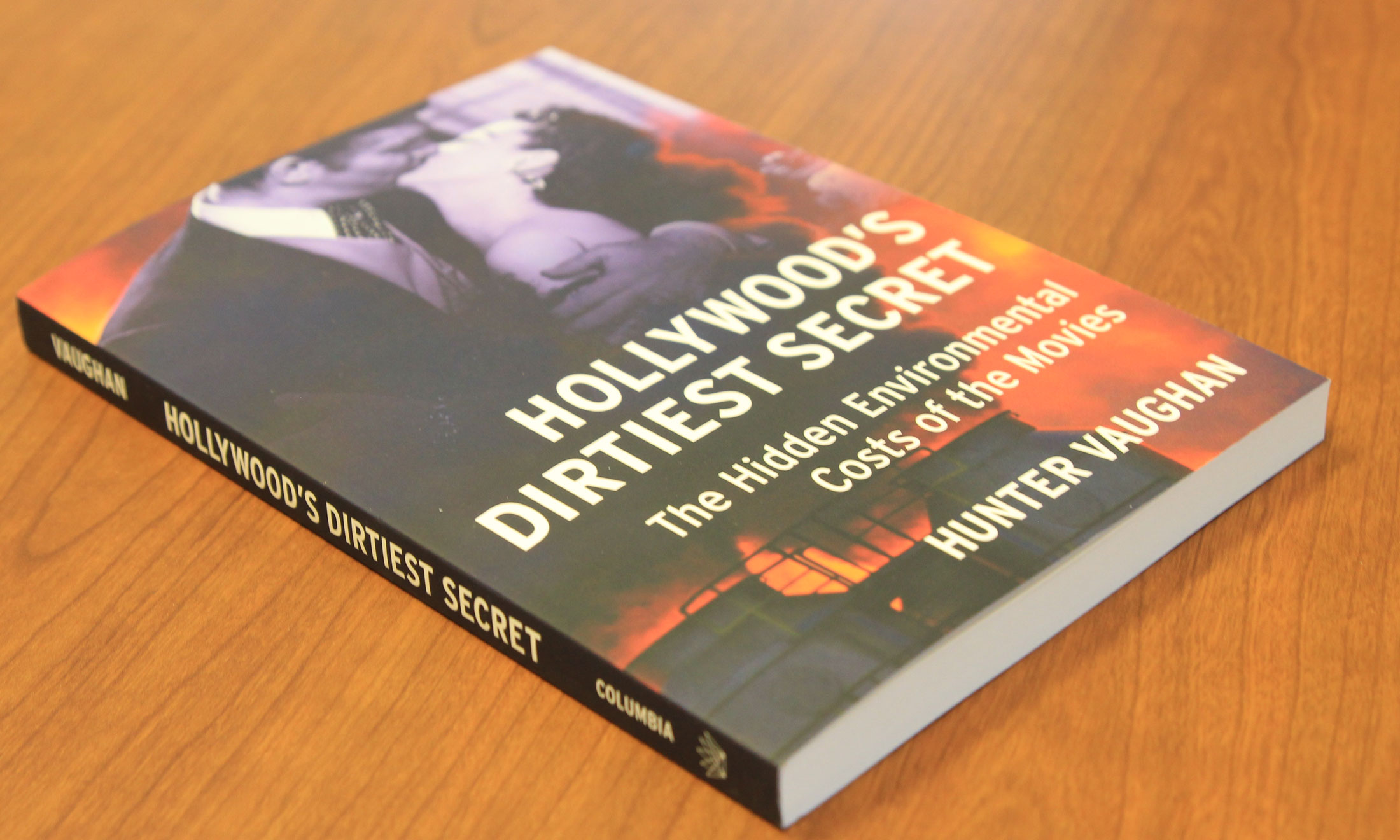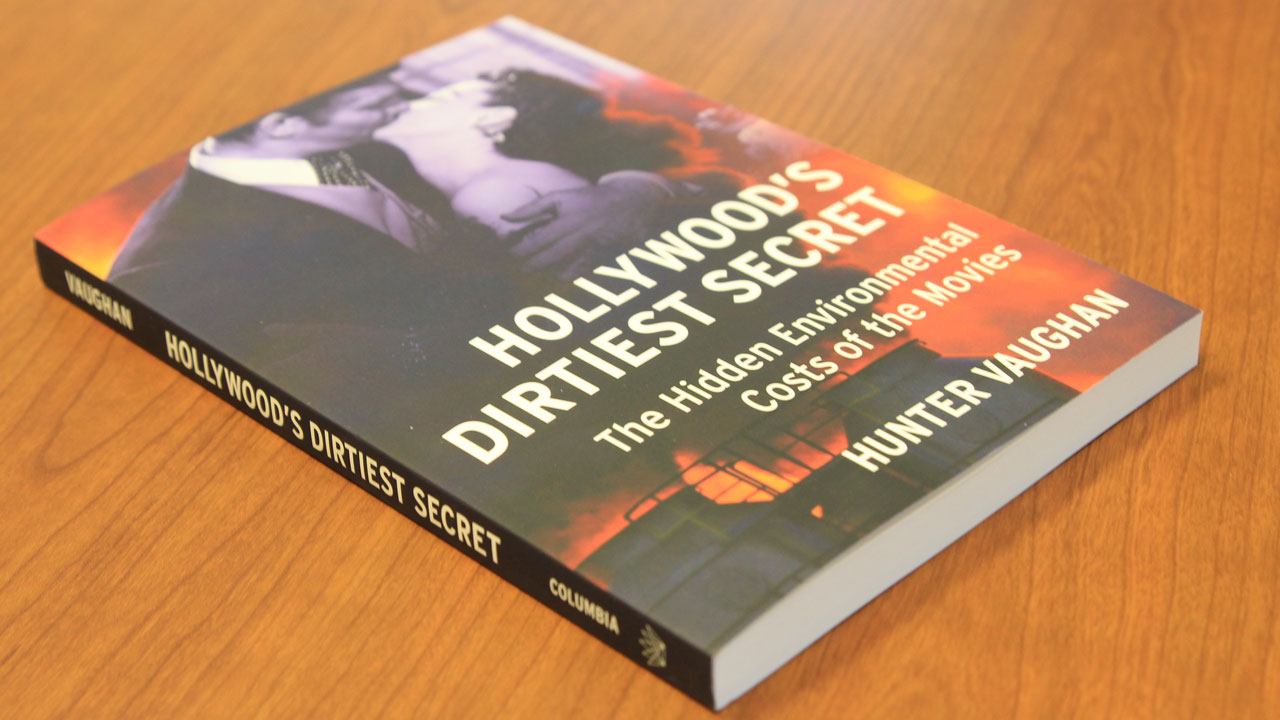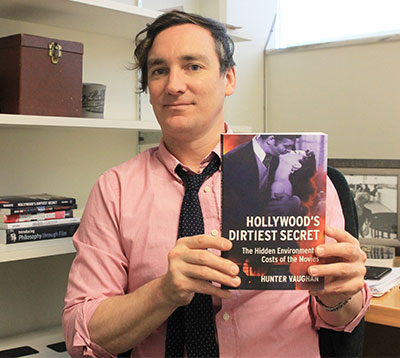‘Hollywood’s Dirtiest Secret’
In his new book, OU film scholar Hunter Vaughan examines the hidden environmental costs of the movies.


In his new book, Oakland University film scholar Hunter Vaughan pulls back the curtain on what he calls “Hollywood’s dirtiest secret.”
Hunter Vaughan, associate professor of cinema studies, is pictured with his new book "Hollywood's Dirtiest Secret." |
The secret is “not lascivious” he writes, “It does not involve a sex tape, murder mystery, executive drama or drug scandal. It’s a much dirtier secret, and we are all in on it. The secret is the hidden environmental impact of how we make, watch and dispose of movies.”
Throughout the book, Vaughn focuses on specific production practices, from water use to fire spectacle – as well as dirty energy practices associated with the digital revolution – to spotlight a dark side of the silver screen.
The following is an interview with Vaughan. It has been edited for length and clarity.
How did you get the idea for the book?
I was in Oxford, England doing my Ph.D., and coming home one night I saw this crazy glow emanating from one of the colleges there. I went in to see what was happening, and it was a massive film shoot for “The Golden Compass.” It just blew my mind looking around at all the material resources being used, and all the energy and the cables and the scaffolding and the intense artificial radiation. It really hit me just how deep the environmental impact of our film culture must be. And with the rising visibility and awareness of climate change issues, it became far more of an urgent topic for me to focus on.
What was your research process like?
When I started looking into the environmental impact of film culture, it became clear that this is something that there’s never been much transparency or record of. Part of that has to do with the fact that environmental debates weren’t even really a thing until the 1960s.
This meant that I had to find other ways to gather the information. I went into archives, museums, special collections and libraries, and looked through memos and letters from producers and directors, to try to read between the lines about how natural resources were viewed and how they were used in classical Hollywood. I tried to take a multifaceted approach that includes industry studies, archive studies, marketing discourse, and advertisements, and also incorporates issues of representation, and social and environmental justice.
The book focuses on four films: “Singin’ in the Rain,” “Gone with the Wind,” “Twister” and “Avatar.” Why are these fitting representations of the hidden environmental costs of the movies?
“Singin’ in the Rain” is really where the book began. There’s a great scene in it where they make a joke about the amount of natural resources used in order to create an artificial sunset. I think this reveals a central Hollywood and American cultural valuation of manufactured spectacle over the natural world. It’s a perfect example of the backstage, semi-ironic Hollywood use of spectacle that is at once meant to be self-reflexive and conscientious of environmental issues, but actually is enjoying all the same luxuries as Hollywood as usual.
“Gone with the Wind” is hugely influential in terms of setting a precedent for Hollywood spectacle. It was a very strange contradiction, because in some ways it was a form of early sustainability practices and recycling. Most of what was destroyed for the burning of Atlanta scene were old set pieces, but it also involved a high degree of piping in of gases to accelerate the inferno. That’s part of why Hollywood is so fascinating; it manifests the contradictions of American ideology so clearly.
“Twister” is important because it’s largely seen as the film that transitioned Hollywood from analogue to digital and CGI (Computer Generated Imagery) production. It, too, is a contradiction because it showed that a digital production was still very resource intensive. It took a lot of resources to produce the storms, and the production company bought homes in the area and destroyed them to show the aftermath of the storms.
In its marketing, “Avatar” represents a strong Hollywood push to re-brand itself as strongly environmental, but when the curtain is pulled back, it is really just business as usual in the movie industry. The film indulged in excessive global transportation and the analog manufacturing of sets, costumes, and props. All of this before digitizing its visual world entirely to run through the CGI ringer – a process itself powered by the very material, resource- and energy-dependent network of servers, satellite signals, and fiber-optic cables that, kept far from the public's view, keep our digital culture humming.
In the book, you compare Hollywood to an invasive species. What do you mean by that?
The final chapter of the book looks at ways in which specific cultures and communities are shaped by their natural landscapes and ecosystems, and how Hollywood’s runaway productions can disrupt those things. I think Hollywood can be viewed as a machinery of wires and cables, metals and plastics, but also as a set of social and cultural values that spread into spaces – such as New Orleans, or south Florida, or British Columbia – that are largely defined by their natural environments.
One example I reference in the book is the movie “Titanic,” where you have a small Mexican fishing village that has been built up over generations in specific relation to its ecosystem. And then through tax breaks and financial incentives, Fox and (Director) James Cameron built this massive production apparatus on the coast of this village and siphoned water through the production set in ways that ended up hurting the marine life and wiping out this fishing community because they no longer have their livelihood.
You mention in the book that you enjoy watching TV and movies, and you’re not advocating for people to abstain from screen culture. What message do you hope people receive from the book?
I enjoy a great movie or TV show as much as anyone else. I think people are going to keep watching movies and buying digital devices and streaming on a daily basis. I would just like for us to be more aware of the costs of our daily entertainment. A large part of the book tries to deconstruct the myth that the digital revolution is a green revolution. As devices get smaller and our storage of information gets more seemingly removed from our daily life, it becomes easier for us to think that buying the newest device is the best thing to do because it might have better battery life or faster processing speeds.
However, we need to realize that the toll for all of this is resource extraction and server farms that are running largely on dirty energy. At some point, it’s going to require a larger shift in worldviews, both on a collective level and on a political level, to address these environmental issues. And it is possible that Hollywood and popular screen culture will be instrumental in helping to motivate and mobilize that shift.


 April 29, 2019
April 29, 2019